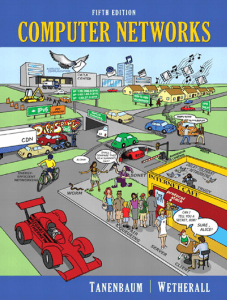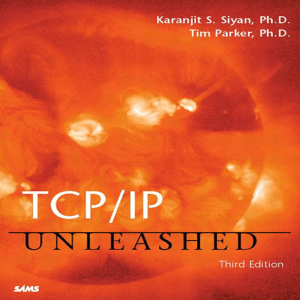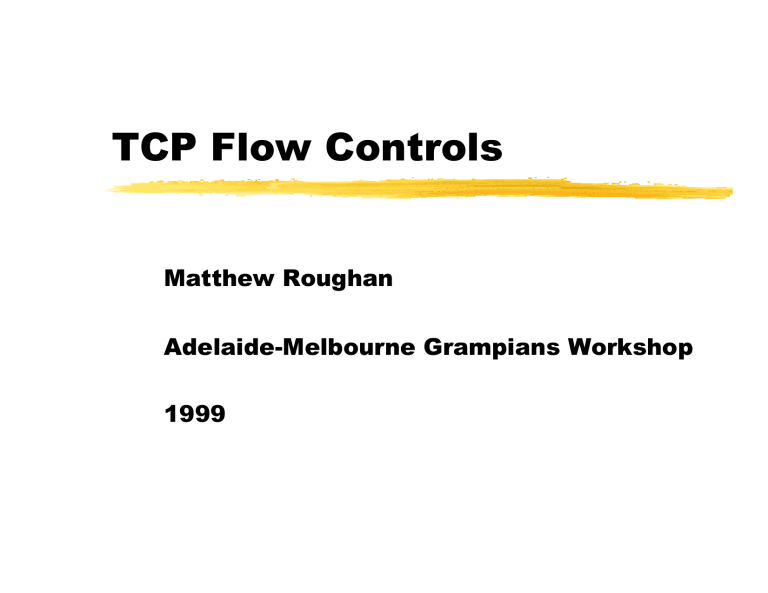
TCP Flow Controls
Matthew Roughan
Adelaide-Melbourne Grampians Workshop
1999
Copyright, 1996 © Dale Carnegie & Associates, Inc.
TCP/IP
Primary protocols used in the Internet
❚ IP (Internet Protocol)
❚ Transmission Control Protocol (TCP)
❚ TCP/IP refers to more than just TCP & IP
❙ TCP is where flow controls are introduced
Why Use Flow Controls?
❚ October1986 Internet had its first
congestion collapse
❚ Link LBL to UC Berkeley
❙ 400 yards, 3 hops, 32 Kbps
❙ throughput dropped to 40 bps
❙ factor of ~1000 drop!
❚ 1988, Van Jacobson proposed TCP flow
control
What are we interested in?
❚ Flow control is now mandatory on TCP
connections
❚ Much is known about the qualitative
performance of the Internet
❙ the Internet works!
❚ Little is known about the quantitative
performance of the TCP flow controls
❙ mostly by simulation, few analytic results
Outline
❚ TCP/IP and the Internet
❙ What is it?
❙ How does it work?
❚ TCP flow controls
❙ window flow controls
❙ TCP implementations
❚ State of the art in performance analysis
❙ 1 p law
IETF
❚ Internet Engineering Task Force
❙ standards organisation for Internet
❙ publishes RFCs - Requests For Comment
❘
❘
❘
❘
standards track
experimental
informational
poetry/humour (RFC 1149: Standard for the
transmission of IP datagrams on avian carriers)
❙ TCP should obey RFC
❘ no means of enforcement
RFCs of note
791: Internet Protocol
793: Transmission Control Protocol
1180: A TCP/IP Tutorial
2581: TCP Congestion Control
2525: Known TCP Implementation
Problems
❚ RFC 1323: TCP Extensions for High
Performance
❚
❚
❚
❚
❚
RFC
RFC
RFC
RFC
RFC
Other Key references
❚ W. Stevens, “TCP/IP Illustrated”, Vol. 1-3
Addison-Wesley, 1994
❚ Vern Paxson, “Measurements and Analysis
of End-to-End Internet Dynamics”
PhD Thesis
❚ Van Jacobson, “Congestion Avoidance and
Control”
SIGCOMM’88
Internet Protocol (IP)
❚
❚
❚
❚
❚
packet switched
unreliable (best effort)
heterogeneous
robust
intelligence is in terminals, not in network
Aims of TCP
❚ TCP seeks to deliver a byte stream
❙ from end-to-end, in order, reliably
❙ allowing multiplexing
❙ use bandwidth efficiently
❚ TCP achieves reliability using ACKs
❚ Robustness Principle
be conservative in what you do,
be liberal in what you accept from others
TCP/IP Protocol Stack
Applications (e.g. Telnet, HTTP)
TCP
UDP
IP
ICMP
ARP
Link Layer (e.g. Ethernet, ATM)
Physical Layer (e.g. Ethernet, SONET)
Packet Terminology
Application Message
MSS
TCP segment
TCP hdr
IP Packet
IP hdr
Ethernet Frame
TCP data
20 bytes
IP data
20 bytes
Ethernet
Ethernet data
14 bytes
MTU 1500 bytes
4 bytes
IP Header Format
0
1
2
3
01234567890123456789012345678901
Vers(4) H len
Type of Service
Identification
Time to Live
Protocol
(TCP=6)
Total Length (16 bits)
Flags
Fragment Offset
Header Checksum
Source IP Address
Destination IP Address
Options
IP data
Padding
TCP Header Format
0
1
2
3
01234567890123456789012345678901
Source Port
Destination Port
Sequence Number (32 bits)
Acknowledgement Number (32 bits)
Data
Offset Reserved
U A P R S F
R C S S Y I
G K H T N N
Checksum
Options
TCP data
Receive Window (16 bits)
Urgent Pointer
Padding
How TCP works
Connection
Client
Server
SYN
SYN-ACK
Internet
ACK
SYN-ACK Handshake established route MTU
How TCP works
Reliable Data Transport
Client
Server
Data
ACK
Data
Internet
ACK
ACKs ensure reliability
with retransmission of unacknowledged data
TCP example client/server
Client
struct sockaddr_in
servaddr;
s = socket(flags);
connect(s,
&servaddr,
sizeof(servaddr));
servaddr is a structure which
contains the IP address and TCP
port number of the server
Server
l = socket(flags);
bind(l, &servaddr,
sizeof(servaddr));
listen(l, LISTENQ);
for ( ; ; ) {
c = accept(l,
&cliaddr,
&clilen);
}
TCP versions
❚ TCP is not perfectly homogenous (200+)
4.2 BSD first widely available release of TCP/IP (1983)
Windows 95
4.3 BSD (1986)
Windows NT
4.3 BSD Tahoe (1988)
4.3 BSD Reno (1990)
IRIX
HP/UX
Digital OSF
SunOS 4.1.3,4.1.4
Solaris 2.3,2.4
NewReno (1999)
?
Linux 1.0
Vegas
Window Flow Controls
❚ Limit the number of packets in the
network to be less than some window W
W × MSS
❚ offered load =
RTT
If W is too small then throughput « bandwidth
If W is too big then load > bandwidth
=> congestion occurs
Effect of Congestion
❚
❚
❚
❚
congestion causes packet loss
results in retransmission
reduces data throughput
in extremes it can cause a collapse which
persists much longer than the original
overload
Congestion Control
❚ IP networks are heterogeneous
❙ bandwidth ranges from 1200 bps to 10 Gbps
❙ network delays range from < 1ms to ~ 1s
❚ TCP seeks to use BW
❙ with high utilisation
❙ without congestion
❚ Window Flow Control
❙ Must choose the window size W correctly
TCP Window Flow Controls
❚ TCP separates receiver congestion from
network congestion, and uses window flow
controls for each
❙ rwnd: receiver window
❙ cwnd: congestion window
❚ TCP must not send data with a higher
sequence number than the sum of the
highest acknowledged sequence number
and min(cwnd, rwnd)
TCP Receiver Flow Control
❚ prevent receiver from becoming overloaded
❚ receiver advertises a window rwnd with
each acknowledgement
❚ Window
❙ closed (by sender) when data is sent and ack’d
❙ opened (by receiver) when data is read
❚ The size of this window can be the
performance limit (e.g. on a LAN)
❙ sensible default ~16kB
TCP Congestion Control
❚ Has four parts
❙ Slow Start
❙ Congestion Avoidance
❙ Fast Recovery/Fast Retransmit
❚ ssthresh: slow start threshold determines
whether to use slow start or congestion
avoidance
❚ Assume packet losses are caused by
congestion
Slow Start
❚ Slow start is used if cwnd < ssthresh
❚ Slow start named because it starts with the
congestion window cwnd = 1
❚ On each successful ACK increase cwnd
cwnd ← cnwd + MSS
❚ The effect is exponential growth of cwnd
each RTT: cwnd ← 2 x cnwd
Congestion Avoidance
❚ Congestion Avoidance is used if
cwnd > ssthresh
❚ On each successful ACK increase cwnd
cwnd ← cwnd + MSS2/cwnd
❚ The effect is linear growth of cwnd
each RTT: cwnd ← cwnd + MSS
Packet Losses
❚ Packet losses may be detected by
❙ Retransmission timeouts (RTO timer)
❙ Duplicate Acknowledgements (at least 3)
Packets
1
2
3
4
5
7
6
Acknowledgements
1
2
3
3
3
3
Fast Recovery/Fast Retrans.
❚ When a packet loss is detected
ssthresh ← max(flightsize/2, 2xMSS)
❚ packet loss detected by a timeout go into
Slow Start (cwnd = 1)
❚ packet loss detected by Dup ACKs
❙ Fast Recovery/Fast Retransmission
cwnd ← cwnd/2
Implementation Dependence
❚ ssthresh initialisation (not standardised)
❙ Reno
❙ Solaris
❙ Linux
ssthreshinit = ∞
ssthreshinit = 8
ssthreshinit = 1
❚ algorithm for incrementing cwnd in CA
❚ Tahoe went into slow start after Dup.ACKs
❙ no Fast Recovery (cwnd = 1)
❚ 1990 Reno had CA window increase
❙ ∆W = MSS2/cwnd + MSS/8
❚ Inspect route cache for history
Bugs
❚ BSDI incorrectly initialised cwnd to 230-214
❚ HP/UX doesn’t clear Dup.ACK counter on
timeout
❚ Linux 1.0 no FR/FR (more like Tahoe)
❚ Linux/Solaris retransmit behaviour was
broken
❙ retransmits every unACK’d packet
Bugs
❚ Windows 95
❙ often when 2 packets are sent one is lost
somewhere in the NIC, so that only 1 is sent.
The second is later sent by retransmission.
❚ Windows NT
❙ no fast retransmit
Timers
❚ An accurate RTT measure is required to
judge timeouts
❚ We can measure RTT by measuring the
time to receive a packets ACK
❚ Use a smoothed RTT, SRTT and the
smoothed mean deviation DRTT
RTO = SRTT + 4 DRTT
Implementation dependence
❚ The measurement of RTT
SRTT = SRTT + g (MRTT-SRTT)
DRTT = DRTT + h ( |MRTT-SRTT| - DRTT)
❚ Need to minimize processing requirements
❙ Only 1 counter (regardless of how many
packets are extant)
❙ Counter granularity is typically 500 ms
❚ Measurement equations have gain par.s
Implementation Dependence
❚ Retransmission Timeout
RTO = β SRTT
❚ Initial RTO (should be > 3 s)
❚ measurement of RTT of retransmitted
packets
❙ from first transmission
❙ from final retransmission
❙ ignore RTT for retransmitted packets (Karn)
Timers on a packet loss
❚ If a timeout occurs, double the RTO and
retransmit the lost packet
❙ results in exponential back-off
❙ recalculate SRTT only when a packet gets
through
❚ RTT is lost if several packets are lost
Delayed Acknowledgements
❚ ACKs may be delayed to ‘piggy-back’ on
returning data packets (by no more than
500ms, typically 200ms)
❚ If multiple packets arrive near to each
other, a single ACK can be used to
acknowledge up to 2 packets
❚ Slow Start and Congestion Avoidance
increment cwnd per ACK, not per ACK’d
packet
Typical networks
Network
Bandwidth
Delay
BWxdelay
10baseT Ethernet
10 Mbps
3 ms
3,750 B
T1 (satellite)
1.544 Mbps
500 ms
96,500 B
GB (transcontinental)
1 Gbps
60 ms
7,500,500 B
TCP Options
❚ Standard TCP performance is limited
❙ max window size (216-1 = 65,535 bytes)
❙ max sequence numbers (232-1 ≅ 4GB=32 Gb)
❚ Options for improved performance
❙
❙
❙
❙
Window scaling (RFC 1323)
Timestamps (RFC 1323)
Selective ACKs (RFC 2018)
larger initial window (RFC 2414, 2415, 2416)
Network management
❚ Explicit Congestion Notification (ECN)
❙ explicit notification of congestion (RFC 2481)
❚ Random Early Detection (RED)
❙ prevent burst of losses when buffers overflow
❙ randomly discard some packets (RFC 2309)
probability
of discard
FIFO Buffer
Performance Analysis
❚ Typical Assumptions
❙ Greedy sources
❘ source always has data to send
❙ Independent losses
❘ packets are lost with probability p, independently
❙ Examine equilibrium behaviour of bulk
transport
Rough Calculation
wn +1
with probability p
w n 2,
=
w n + 1 wn , with probability 1-p
w
= pw 2 + (1-p )(w + 1 w )
w p 2 = (1-p ) w
w2
= 2(1-p ) p
p«1
w ≈
2
p
Refinement
Padhye, Firoin, Towsley and Kurose
SIGCOMM'98
❚ Treat as a Renewal Reward Process Take into account
delayed ACKs
MSS
3
B( p) =
RTT 2bp
❚ Include timeouts as well as Dup.ACKs
B( p) =
MSS
2bp
3bp
p 1 + 32 p 2
RTT
+ T0 min1,3
3
2
❚ Include Receive window
MSS
, B( p)
B( p ) ≅ minWr
RTT
(
)
Possible future work
❚ more realistic loss model
❚ finite sources (not greedy)
❚ investigation of interaction
❙ people have noticed synchronisation
❙ chaotic behaviour
❙ LRD arising from retransmissions
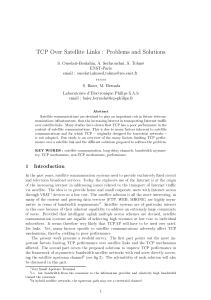
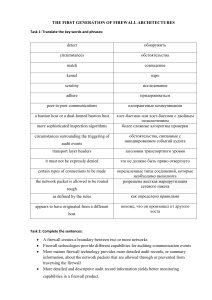

![Computer Networking - A Top-Down Approach 6th [2013] (0132856204)](http://s1.studylib.ru/store/data/006373198_1-49ab5064ac9f22b513758b7e3bfbfbee-300x300.png)
![Этап: 2. Сканирование [Scanning]](http://s1.studylib.ru/store/data/005027200_1-078be7b4757bbc5d820a2b3f8589def0-300x300.png)
